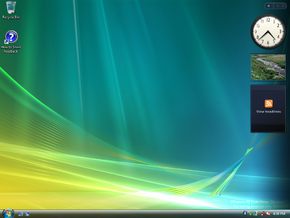Windows 7 build 6469
| Build of Windows 7 | |
 | |
| OS family | Windows NT |
|---|---|
| Version number | 6.1 |
| Build number | 6469 |
| Build revision | 1 |
| Architecture | x86 |
| Build lab | fbl_find_dev |
| Compiled on | 2007-10-02 |
| Expiration date | |
| Timebomb | 2008-04-07 (+188 days) |
| SKUs | |
| Starter Home Basic (N) Home Premium (N) Business (N) Enterprise (N) Ultimate (N) | |
| Product key | |
| Use a Windows Vista retail key | |
| About dialog | |
Windows 7 build 6469 is the earliest available build of Windows 7, which was uploaded to BetaArchive on 26 April 2011.[1] This build is specific in that it was compiled as a private build, with binary files having the VS_FF_PRIVATEBUILD flag set in their version information and the builder user name being present in the build tag, although user name appears to suggest that it was compiled by the official shell build lab account, internally referred to as WEX Build Lab Account (the display name of the wexbuild account, additionally responsible for signing most binaries).
This is the last build to show the information regarding the system's RAM on the About Windows applet, which had been present since Windows 1.0. It is also the last build to have the Windows 2000-era banner in the aforementioned applet, and to include the Windows Sidebar before being replaced with the Desktop Gadget Gallery in build 6471.
Due to its earliness, this build identifies itself as Windows Vista in most areas. Curiously, the EULA refers to this build as "Microsoft Windows Vista Service Pack 1", implying that this build was forked from a late Windows Vista Service Pack 1 build.
New features and changes[edit | edit source]
Hardware compatibility[edit | edit source]
Product policies for the Starter edition have been changed to allow up to four gigabytes of random access memory to be installed and used on the user's computer.
User interface[edit | edit source]
The Classic Start menu first introduced as part of Windows 95 has been completely removed and can no longer be enabled, although the respective registry value still exists in code and references to the classic menu option are still present in the Help and Support Center at this stage in development. Minor design updates have been made towards the Windows Explorer command bar to sport a blue appearance, and references to the project's codename are now present across specific parts of the user interface, including the watermark and the static /NOGUIBOOT boot screen bitmap. The taskbar texture has also been slightly updated to reflect changes made for the Superbar, which is discussed later in the article.
The classic Control Panel view has been renamed to "All Control Panel Items" and redesigned to feature a tile-based view of each individual Control Panel applet present in the operating system. The left-hand options sidebar has been minimized and now includes a single option that points directly to the Control Panel home page. The Welcome Center applet icon has additionally been updated to include a registration card beside the operating system's product packaging design. The applet itself was updated to show only 3 items in the Get started with Windows category. The user now has the ability to choose which volumes to defragment in the Disk Defragmenter utility. The Windows PowerShell command-line interpreter has also been added to the operating system.
Internal self-host builds of Windows 7 now include the "How to Share Feedback" HTML application from previous builds of Windows Vista.
WinSAT Aurora[edit | edit source]
WinSAT Aurora has been removed.
Miscellaneous[edit | edit source]
- The minor kernel version has been incremented by one.
- This is the earliest known build to include the
KernelBase.dlldynamic link library; a majority of core operating system kernel functions found in thekernel32.dlldynamic link library (which include (but are not limited to) slim read/write locks, time/date operations, natural language selection, thread pooling and file I/O operations) have been moved over to this newly introduced component.
Setup[edit | edit source]
- Setup now requires Windows Vista with Service Pack 1 to upgrade.
Findings[edit | edit source]
Superbar[edit | edit source]
This build includes an early iteration of the Superbar, which largely functions identically to the existing taskbar implementation in Windows Vista; there is no support present for dragging across or pinning applications to the taskbar at this stage in development, but includes functionality for combined application labels and updated designs for the taskbar as well as task thumbnail previews. It can be enabled by merging the below values into the current local user account's registry hive and restarting the Windows Explorer shell:
[HKEY_CURRENT_USER\Software\Microsoft\Windows\CurrentVersion\Explorer\TaskBand]
"CanHasSuperbar"=dword:00000001
Libraries[edit | edit source]
An early implementation of the Libraries system, which was originally planned to be included as part of the original Windows Vista release but subsequently dropped, is present in this build. The implementation at this stage is barebones and does not offer much functionality within it, although an option to display libraries, a predefined "Documents" library folder and a non-functional "add location" wizard is present in the system. Like the Superbar functionality, it can be enabled by merging the below values into the current user's registry hive and subsequently restarting the shell:
[HKEY_CURRENT_USER\Software\Microsoft\Windows\CurrentVersion\Explorer\Advanced]
"UseWin7NavPane"=dword:00000001
Bugs and quirks[edit | edit source]
People Near Me[edit | edit source]
People Near Me (and thus also Windows Meeting Space) fails to launch with error 0xc0150002.
Desktop icons[edit | edit source]
Showing the Control Panel icon on the desktop will also cause All Control Panel Items to show.
Login screen[edit | edit source]
The keyboard layout button has no outline.

















